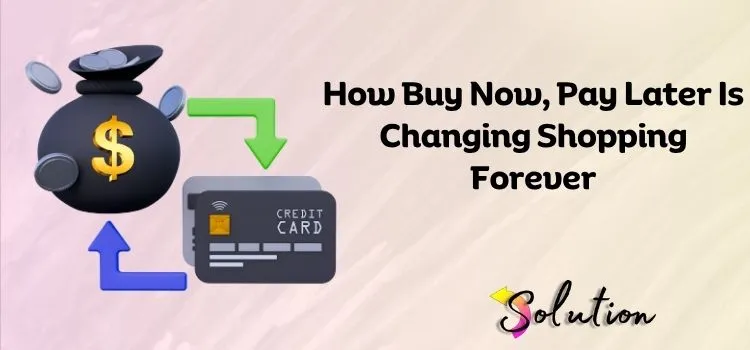
Just picture yourself browsing your favorite store for the ideal pair of sneakers, making a purchase, and then leaving the store with them—all without paying a dime. A few clicks on your phone are all it takes—no credit card swipes, no loan applications. Buy Now, Pay Later (BNPL) services have made this scenario a reality, not some far-fetched vision of a perfect retail utopia.
BNPL, once a specialist product, has quickly transformed consumers’ interactions with their finances into a mainstream payment option. This strategy enables consumers to divide their purchases into smaller, interest-free installments; it has been popularized by fintech disruptors such as Klarna, Affirm, and Afterpay. Getting what you want right away without having to pay in full is a huge selling point.
However, BNPL is more than simply a shopping alternative; it is also changing the way consumers behave, posing new challenges about financial accountability and regulation and casting doubt on established credit structures. Companies are rushing to adopt these versatile payment methods in the hopes of attracting customers in a cutthroat industry, where their popularity is skyrocketing among millennials and Gen Z.
The reasons behind the growth of BNPL, its effects on the retail and financial sectors, and its implications for future expenditure are all topics that will be covered in this article. No one, from curious consumers to CEOs, can afford to ignore the BNPL revolution.
Also Read:- The Importance of CPA Firms for Growing Healthcare Facilities
A Brief About Buy Now, Pay Later (BNPL)
With a digital makeover, the age-old concept of installment payments is given a modern twist with Buy Now, Pay Later (BNPL). The essence of BNPL is that it allows customers to buy things now and pay for them later, usually in four equal, interest-free installments. Customers have an intuitive and convenient alternative with these services because they are typically built right into online and in-store checkout systems.
Hundreds of merchants have joined together with industry leaders like Klarna, Afterpay, Zip, and Affirm to make BNPL easy to use with a few taps. In most cases, BNPL does not require a credit check or charge interest as long as payments are paid on time, unlike conventional credit cards.
Younger consumers who are hesitant to go into debt or lack established credit find this to be a great perk.
However, BNPL benefits not only customers but also retailers. Boosted conversion rates and higher average order values are further benefits for retailers. With the rise of e-commerce, BNPL is becoming a powerful instrument that benefits brands and consumers alike.
Anyone looking to make better, more educated financial decisions in today’s fast-paced buying environment would do well to familiarize themselves with the notion of BNPL and how it operates.
Also Read:- Beginner’s Guide to Start Investing in Cryptocurrency
The Psychology Behind BNPL Adoption
A significant factor contributing to BNPL’s popularity among contemporary shoppers is its appeal to instant gratification. Instant gratification is a powerful psychological principle that BNPL fundamentally uses. The human brain inherently craves instant gratification. With BNPL, buyers can immediately experience the joy of ownership without incurring significant costs, resulting in a situation that appears to benefit both parties.
This method of payment deftly lessens the burden of payment. The thought of paying for a $200 purchase in four $50 installments is much less intimidating than paying the entire amount all at once. What psychologists term “mental accounting” is how we justify lower payments as more manageable, even when the final amount remains the same.
Customers’ needs for personalization and adaptability are also met. Younger generations, such as Millennials and Gen Z, are understandably wary of conventional lending, but BNPL’s short-term, structured plan makes paying back loans easier and more manageable.
Finally, BNPL platforms take advantage of gamified experiences, real-time approvals, and elegant, mobile-first interfaces to provide an easy experience, empowering, and enjoyable. Designed with ease of use in mind, it satisfies both irrational spending desires and practical financial needs.
To sum up, BNPL alters our attitudes about spending as much as it does our methods of payment.
Also Read:- Practical Steps to Financial Independence
Risks and Pitfalls of BNPL
Although BNPL services offer convenience and adaptability, they also carry risks that, if ignored, can build up over time. Multiplying what appears to be a harmless $50 installment across numerous purchases and platforms can rapidly lead to a debt trap.
In terms of dangers, overspending ranks high. Consumers are more inclined to make impulsive purchases they wouldn’t have otherwise made thanks to BNPL, which reduces the immediate cost burden. Irresponsible spending and overshopped trolleys, with no apparent way to pay it off, might result from the allure of affordable prices.
The problem of missed payments follows. While BNPL services typically do not charge interest, late fees can quickly accumulate. Combined with the stress of managing multiple active installment plans, these late fees can significantly impact your monthly budget. Worst-case scenario: some providers even start reporting to credit bureaus, which can lead to collection activities or even lower your credit score.
Furthermore, unlike with more conventional forms of lending, customers may not be as protected due to the lack of regulation in many areas. Providers’ terms and costs can differ substantially, leading to misunderstandings and possible financial blunders.
If proper planning and budgeting aren’t in place, BNPL has the potential to be a useful tool.
Also Look:- Long-Term Business Success
Top BNPL Providers: Who’s Leading the Market?
A few companies have emerged as leaders in the Buy Now, Pay Later (BNPL) industry, revolutionizing the shopping habits of millions of individuals worldwide. These innovative financial technology companies are not only ruling the industry, but they are also developing new products and services all the time.
- Klarna, a Swedish Bank
Klarna, a household name in BNPL, gives customers a lot of choice when it comes to how they pay, with options like “pay in 4,” “pay later in 30 days,” and financing plans. Globally, Millennials and Gen Z love Klarna because of its stylish app and strong retail partnerships, such as H&M and Sephora.
- Afterpay (Australia)
Afterpay became well-known as an industry trailblazer thanks to its straightforward, interest-free payment plan. Major companies like Nike and Urban Outfitters are on board, and it now has a significant presence in Australia, the U.S., and worldwide, thanks to Block Inc. (previously Square).
- Affirm (USA)
The absence of late fees and upfront pricing makes Affirm stand apart. It’s commonly utilized for more expensive things like electronics or vacations. Affirm dominates in the North American market thanks to its relationships with major players, including Walmart, Peloton, and Amazon.
- Zip (Australia)
Zip is flourishing in several nations, including the US, UK, and NZ, thanks to its flexible payment plans that include both short- and long-term installments. Individuals seeking adaptability outside the immediate paradigm are the target audience.
- PayPal (USA)
With “Pay in 4,” PayPal joined the BNPL game, allowing its enormous user base to split purchases during checkout effortlessly.
The increasing number of different providers, each of which offers something special, demonstrates how fundamental BNPL has become to the contemporary consumer’s purchasing experience.
Also Read:- What is International Trade
Conclusion
Buy Now, Pay Later (BNPL) has rapidly evolved from an innovative idea to a transformative force in consumer finance. It entices contemporary consumers who value convenience and control by combining quick satisfaction with adaptable payment methods. However, it is crucial to use it responsibly, just like any other financial tool.
Recognizing and controlling the hazards associated with BNPL is crucial, as it can also empower customers and drive retail growth. To keep this model viable in the face of ever-changing regulatory frameworks and a growing market, users and businesses alike will need to be flexible.
If you want to confidently navigate the future of commerce, whether you’re an inquisitive shopper or a corporate leader, you must understand the dynamics of BNPL.


